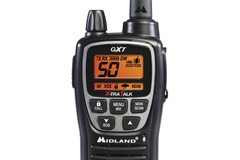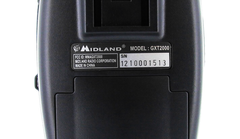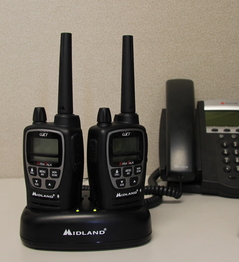 It's been a few days now since the brand new Midland GXT2000VP4 walkie talkie first arrived, so we've had a little time to kick the tires and find out what we like and what we don't. When we shot our first impressions / unboxing video, we were relying only on information provided by Midland, so it was a lot of fun to actually get to try out this long awaited two way radio.
It's been a few days now since the brand new Midland GXT2000VP4 walkie talkie first arrived, so we've had a little time to kick the tires and find out what we like and what we don't. When we shot our first impressions / unboxing video, we were relying only on information provided by Midland, so it was a lot of fun to actually get to try out this long awaited two way radio.
In this review we are going to draw a lot of comparisons to the Midland GXT1000VP4 walkie talkie. The GXT2000 is in many ways an extension of the GXT1000, and many of the features are the same. This review is going to concentrate on the differences between these two models, so you may want to take a look at a GXT1000VP4 review or two. It's also important to mention that even though we are testing the GXT2000, this info should also apply to the new Midland GXT2050VP4. The GXT2050 is basically the same radio except for the Mossy Oak camouflage and a few extra call tones. That said, let's look at a few features.
Power
 The GXT2000VP4 has a different FCC ID number than the GXT1000, which usually means that there were enough changes between the two models that Midland had to have the product tested and submitted for approval. Much of this test information is public, so we can see that the GXT2000VP4 was tested and found to have 2.649 watts of output power. This is less than half of 5.33 watts that the GXT1000 was reported to be pumping and is a slight disappointment. This is still a nice jump over the 1.67 watts of the Motorola MT352, for example, but we were anxious to see if this drop in reported power had any impact on the range in our real world test.
The GXT2000VP4 has a different FCC ID number than the GXT1000, which usually means that there were enough changes between the two models that Midland had to have the product tested and submitted for approval. Much of this test information is public, so we can see that the GXT2000VP4 was tested and found to have 2.649 watts of output power. This is less than half of 5.33 watts that the GXT1000 was reported to be pumping and is a slight disappointment. This is still a nice jump over the 1.67 watts of the Motorola MT352, for example, but we were anxious to see if this drop in reported power had any impact on the range in our real world test.
A true comparison to the GXT1000 was what we wanted, so we took both radios to eight different locations in the area surrounding our office. These locations varied from .4 to 2.13 miles away. On our "test course" both radios performed very well at all locations at or within 1.5 miles - the audio was easily understandable and background noise was not overly distracting. At less than a mile, transmissions were even more clear and background noise was minimal. Our course included two locations that are in excess of 2 miles, and this is where we started to experience issues. At one location (2.13 miles away, 10 meter elevation difference) we were able to communicate consistently, but with moderate to severe background noise. The GXT2000VP4 outperformed the GXT1000 at this location, doing a better job of noise reduction. The other location was 2.1 miles away with the same elevation as our office and we were not able to communicate consistently with either radio. The GXT1000 would break squelch occasionally, but the GXT2000VP4 didn't give as much as a hint that it was sniffing out a signal.
Based on the test, it does seem like the GXT2000 has less power than the GXT1000, but this was only noticeable when we were pushing the very edge of the range for both radios. The GXT2000VP4 makes up for this, in a way, with what seems like better noise reduction. In many of the locations we felt the GXT2000 had a stronger signal because the voice sounded louder and there seemed to be less background noise.
Lithium Battery
 The most touted feature of the GXT2000 is its lithium polymer battery. Lithium batteries have a decided advantage over NiMH in that they are lighter and don't suffer from the "memory effect". There are few manufacturers of consumer grade GMRS radios using lithium batteries and we're excited to see Midland move to this technology. Midland advertises these batteries as having twice the power and three times the charge speed of the previous model. That is an average life of around 16 hours and a 2 hour recharge time. Both are impressive numbers.
The most touted feature of the GXT2000 is its lithium polymer battery. Lithium batteries have a decided advantage over NiMH in that they are lighter and don't suffer from the "memory effect". There are few manufacturers of consumer grade GMRS radios using lithium batteries and we're excited to see Midland move to this technology. Midland advertises these batteries as having twice the power and three times the charge speed of the previous model. That is an average life of around 16 hours and a 2 hour recharge time. Both are impressive numbers.
We discovered a couple of facts worth noting in regard to the batteries. First of all, Midland doesn't seem to be advertising that the GXT2000VP4 will operate on standard "AA" batteries as well as the included lithium ones, but we confirmed that they will! This is a nice feature if you find yourself needing radios right away and don't have time to charge them.
It's also important to note that the charger is NOT compatible between the GXT1000 and GXT2000. The radios are the exact same size and have the same footprint, but the technology required to charge a lithium battery is different from that required to charge NiMH. Midland has taken some precautions by changing the GXT2000 charging base slightly so that a GXT1000 radio will not be able to rest on the charging contacts. The plug size is also different on the back of the charger so it isn't possible to use the same wall or vehicle plug.
Audio Quality
This may actually be our favorite new feature. The GXT2000 lists "HD Audio" as a feature on the back of the packaging, but this feature wasn't heavily promoted by Midland so we were very curious as to what it meant. Well, it didn't take long to find out! The volume on the GXT2000 is noticeably louder and clearer than the GXT1000. There was an issue with previous Midland models in which the radio volume was very low when an accessory was connected. We connected an XLT SM300-ML1 to the GXT1000 and the volume could be heard, but would be a struggle in a noisy room. The GXT2000 was considerably louder and more on par with what you would expect.
We compared a Midland GXT2000 to a Motorola MR350R, both using the XLT SM300 speaker mic. At maximum volume the output from the speaker was around the same loudness, but the GXT2000 seemed clearer.
The "HD Audio" feature may also be responsible for the reduced noise noted above.
Larger Display
Midland's press release states that "the GXT2000 series adds an improved LCD screen that is larger and easier to read". Honestly, we're not too impressed. The technology used for the display is identical to what was used previously. The new screen may be slightly larger, but it is hard to see a difference. The layout is definitely different, with a row of icons underneath the main portion of the screen, but that doesn't necessarily make it easier to read. Like most FRS and GMRS radios, you still need to have some idea of what the icons and acronyms that are shown mean if you want to explore any advanced functions.
Direct Call / Group Mode
The GXT1000 had a direct call and a group mode feature, and Midland removed both of these in the GXT2000VP4. These features were very difficult to use - you almost had to have the manual in front of you just to use it. We would love to see Midland implement this functionality in a future model, but make it more intuitive and easier to use. If having these features in the GXT2000 meant that they had to work the same way they did in the GXT1000 then we're probably better off not having it. It only leads to unhappy customers when someone buys a radio because they want direct call, and then they get it and find out it is more difficult to use than it's worth.
Weather Scan
Midland also added the ability to scan weather channels with the GXT2000. This is new, and when activated the radio automatically scans the NOAA weather channels until it finds one with a signal. If you move out of range or the signal stops then it continues to scan. We're not huge fans of this feature. It's common to be in an area that can receive a broadcast from more than one NOAA station, and you're better off selecting the station that is closest to you. Relying on weather scan could result in landing on a station that is a good distance away and broadcasting weather for a different area. We can understand that it may be useful while travelling, but generally we recommend you avoid this feature.
Conclusion
We are fans of the Midland GXT2000VP4. They have definitely improved the audio quality and accessory volume. The lithium batteries are lighter and longer lasting than the NiMH batteries in previous models, but Midland didn't sacrifice the ability to operate on standard AA's. The power of this radio does seem to be lower, but in our testing this was made up for by the improvements in audio.
Do you have a Midland GXT2000VP4? We would love to hear from you! Please leave a comment below and let us know what you think of it!









Steve,
I'm not completely sure about the power output. I take power numbers from the FCC's "Grant of Equipment Authorization" for the FCC ID of the product. I've found through the years that the "Output Watts" shown on this grant is fairly consistent with the range that we see from the radios. I don't have access to the equipment necessary to verify that the number is right, but I can say that generally a radio that shows 3 watts on this grant has better audio quality at a distance than one that shows 1.5 watts. There are exceptions to this and the GXT2000VP4 could certainly be one - I said in the review above that in most instances I thought the GXT2000 sounded better than a GXT1000 despite the reported difference in power.
We've been a Midland dealer for a long time and I have a lot of respect for those guys. They've got an excellent product line and I like some of the risks that they've taken (GXT5000 for example). Historically however, and this applies to all manufacturers, I've found that the wattage number displayed on the FCC grant more accurately reflects the capabilities of the radio than the power reported by the manufacturer.
Whether you are relying on the number given by the FCC grant or by the manufacturer, the output power number is just a number. While it's nice to think that we can sort of sum up a radio's performance with this number, it's often going to be based on the output of one sample sent to one lab, and test equipment and component quality can certainly vary. At the end of the day I would encourage people to rely more heavily on reviews based on actual real world usage than on these power numbers when making purchasing decisions.
Are you sure about the power output rating? If you compare FCC documents for various radios, you'll see the reporting is all out of whack. Look at more than just two and you can't make any sense of them. So I called Midland, and they confirmed that all newer (since the last 6 years+) are 5W radios, with an output in GMRS freqs on High of about 4.5W. Same as GXT1000, 860, 760, etc, etc.